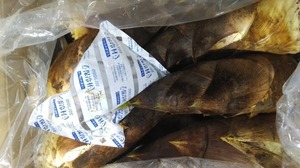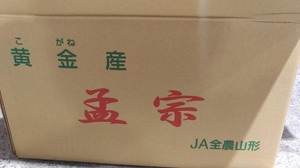It grows fast and is said to become bamboo; 竹 in 10 days. From that, the word “Bamboo Shoot; 竹の子, 筍” was applied. Being a young stem extending from the underground stem of Bamboo. “Meng Zong”(Originally from Jiangxia County, Jingzhou, he is one of the twenty-four Filial Exemplars)≒ Moso bamboo (Phyllostachys pubescens)
On May 23, 2019, 13 5th graders from Kogane Elementary School in Tsuruoka City experienced rice planting in five ares of paddy fields at Seiryu-ji Temple in Tsuruoka City. Four employees of Tsuruoka Green Farm Co., Ltd., which provides the farmland, and the deputy manager of agricultural economics at the time of JA Tsuruoka Minami Branch served as lecturers, and glutinous rice "Koyuki glutinous rice" (glutinous rice developed independently by Yamagata Prefecture, As the name suggests, it has a beautiful whiteness and luster, sweetness and chewy like powdered snow.” Registered on October 30, 2009. No anthocyanin color on the leaf auricle. Posture of flag leaf blade (initial observation) is upright. Heading period (50% heading) is medium. , excluding floating rice) is slightly long, the length of the main axis is slightly long, the number of ears is slightly small, the distribution of awns is only at the tip, the number of trichomes on the outer glume (spikelet) is medium, the color of the tip of the outer glume (Tip color) (Spikelets) are red, the degree of curvature of the main axis is drooping, the ear shape is spindle-shaped, the maturity stage is medium, the glaze color is yellowish white, the length of the glumes is medium, the glume color is yellowish white, Paddy 1000 grain weight is medium, no phenol reaction in grain, brown rice length is medium, brown rice width is medium, brown rice shape is semicircular, brown rice color is white, brown rice aroma is absent or very weak, leaves medium green color, stigma color white, culm thickness medium, awns present, awn color (initial observation) yellowish brown, longest awn length very short, panicle extraction degree Axis is well extracted, endosperm type is glutinous, endosperm amylose content is type 1, impaired cold tolerance is strong, ear germination is easy, lodging resistance is slightly strong, grain shedding is difficult, blast resistance presumed gene The type is Pi-k, the field resistance to ear blast is strong, the field resistance to leaf blast is slightly weak, and the field resistance to bacterial leaf blight is medium. Compared to the control variety "Hime no Mochi Rice", the applied variety "Koyuki glutinous Rice" has a red color of the tip of the outer glume (spikelet) and has strong resistance to cold, etc. Distinction is recognized in. Compared to the control cultivar "Dewa no Mochi Rice'', the color of the tip of the outer grain (tip color) (spikelet) is red, the weight of 1000 grains is medium, and the disordered cold resistance is stronger. It is said that the distinction is recognized by being. Tsuruoka City Kogane Elementary School (School districts: Seiryuji district, Takizawa district Kamiyamadani district, Kanaya district, Yasada district, Kotobuki district, Nakahashi district, Minda district, Kosaka district, Shinseki district) The school educational goals are lively, warm and golden. Child. Fostering children who are proud of their hometown gold and carve out their own future. Shonai Plain, Yamagata Prefecture: It is nurtured by the flow of the mogami river and Akagawa river from different sources. To the north Mt. Chokai : Dewa Sanzan (Three Mountains of Dewa ; Shrine-Mt. Haguro, Mt. Gassan, Mt. Yudono) to the east-It is said that Koteko's son, Prince Hachiko, escaped from the capital at the discretion of Prince Umayado (Prince Shotoku), and became the founder of Dewa Sanzan (Three Sacred Mountains of Dewa) in Tsuruoka City, Yamagata Prefecture. South is surrounded by mountains in the Asahi mountain range(寒江山, 小朝日岳, 平岩山, 鳥原山, 祝瓶山 etc.)- One of Japan's leading granary areas, with large sand dunes on the west side facing the Sea of Japan. Humans settled in the Region as far back as the Paleolithic and Jomon periods. Southern hills and foothills : The ruins of hunting life at that time are interspersion. In the Kofun period, people also settle in the lowlands of the plains. He started his rice-growing life under the control of a powerful family. At the end of the Heian period, a manor called Oizumi-sho was set up in this region. “Gikeiki”, 大泉荘大梵寺を通せ給ふ - Description, Daibonji Temple later became known as Daihoji Temple. Eventually it will become the center of Oizumi-sho. At the beginning of the Kamakura period, Mr. Muto ruled as lord of a manorof Oizumi-sho. Since then, it has prospered as a regional center throughout the Middle Ages : In the 1530s, seeking harm during the war : Take up residence at Oura Castle (now Oyama). From the Middle Ages, Mt. Haguro was a major force here. It is said that he also served as a steward and protected Kurokawa thickly(Inherited for more than 500 years by the parishioner ; It is divided into an upper seat and a lower seat, which are Noza (farmer) of the guardian Kasuga Shrine. Oral biography of the 56th Emperor Seiwa. Designated in 1976 as a national important intangible folk cultural property.). After the fall, Shonai will be under the control of Echigo Uesugi. In 1591, Kanetsugu Naoe built Daihoji Castle as a political base. The Naoe army attacked the Yamagata Castle fiercely, and finally besieged the Hasedo Castle, the advance-guard station of the Yamagata Castle (the Battle of Dewa in the Keicho Era or the Battle of Hasedo). As a result of the Battle of Sekigahara, Yoshiaki Mogami, the lord of Yamagata, ruled Shonai in 1601. Daihoji Castle is maintained as a retired castle : In 1603, the name was changed to Tsurugaoka Castle. Entering the Edo period, Mr. Mogami was confiscated in 1622. Instead, Tadakatsu Sakai (140,000 koku of rice in Fudai Daimyo)entered the country as the lord of the Shonai clan. The castle town is maintained with Tsuruoka as the residence-To build on the basics. The Shonai clan has Akumi District and Tagawa District. This is administratively divided into Kawakita Misato and Kawanami Five Streets. 中川通, 櫛引通, 京田通, 山浜通 - The Shonai clan was ruled by the Sakai clan for about 250 years. From the Restoration down to the present. In 1869, Mr. Sakai repatriates the edition.etc. “平成の大合併” - 鶴岡市, 藤島町, 羽黒町, 櫛引町, 朝日村, 温海町が合併 - 平成17年10 月1日に, 新鶴岡市が発足 - With an area of 1,311.53 km2, it is the largest city in Tohoku. Formulated a comprehensive plan in January 2010.“藤沢周平(Mr. Tomeji Kosuge)”, Born December 26, 1937. 旧東田川郡黄金村大字高坂 ; Oaza Takasaka, Tsuruoka City - 暗殺の年輪, 1973 ; 文藝春秋, 又蔵の火, 1974 ; 文藝春秋, 闇の梯子, 1974 ; 文藝春秋, 檻車墨河を渡る, 1975 ; 文藝春秋, 改題 : 雲奔る 小説・雲井龍雄 ; 中公文庫, 竹光始末, 1976 ; 新潮文庫, 時雨のあと, 1976 ; 新潮文庫, 義民が駆ける, 1976 ; 中央公論社, 講談社文庫,冤罪,1976 ;新潮文庫,暁のひかり,1976 ;文春文庫,逆軍の旗, 1976 ; 文春文庫, 喜多川歌麿女絵草紙, 1977 ; 講談社文庫, 闇の穴, 1977 ; 新潮文庫, 闇の歯車, 1977 ; 講談社, 長門守の陰謀, 1978 ; 講談社文庫, 春秋山伏記, 1978 ; 家の光協会, 角川文庫, 一茶, 1978 ; 文藝春秋, 神隠し, 1979 ; 新潮文庫, 雪明かり, 1979 ; 講談社文庫, 回天の門, 1979 ; 文藝春秋, 驟り雨, 1980 ; 新潮文庫, 橋ものがたり, 1980 ; 新潮文庫, 出合茶屋 神谷玄次郎捕物控, 1980 ; 双葉社, 改題: 霧の果て, 1985 ; 文春文庫, 闇の傀儡師, 1980 ; 文藝春秋, 夜の橋, 1981 ; 文春文庫, 時雨みち, 1981 ; 新潮文庫, 霜の朝, 1981 ; 新潮文庫, 密謀, 1982 ; 新潮文庫, よろずや平四郎活人剣, 1983 ; 文藝春秋, 龍を見た男, 1983 ; 新潮文庫, 海鳴り, 1984 ; 文藝春秋, “白き瓶-小説 / 長塚節”, 1985 ; 文藝春秋, 花のあと, 1985 ; 文春文庫, 風の果て, 1985 ; 文春文庫, 決闘の辻: 藤沢版新剣客伝, 1985 ; 講談社, 潮田伝五郎置文, 1985 ; 東京文芸社, 本所しぐれ町物語, 1987 ; 新潮文庫, 蟬しぐれ, 1988 ; 文藝春秋, たそがれ清兵衛, 1988 ; 新潮文庫, 市塵, 1988 ; 講談社(日本歴史文学館), 麦屋町昼下がり, 1989 ; 文藝春秋, 三屋清左衛門残日録, 1989 ; 文藝春秋, 玄鳥, 1991 ; 文藝春秋, 天保悪党伝, 1992 ; 新潮文庫, 秘太刀馬の骨, 1992 ; 文藝春秋, 夜消える, 1994 ; 文春文庫, 日暮れ竹河岸, 1996 ; 文藝春秋, 漆の実のみのる国, 1997 ; 文藝春秋, 静かな木, 1998 ; 新潮社, 未刊行初期短篇, 2006 ; 文藝春秋-鶴岡市青龍寺金峯, 高坂字大台, 滝沢字薬師嶽, “藤沢”字荒沢 : Designated date : April 23, 1941-Management organization name : Tsuruoka City(S17・6/23) : Historic site scenic spot natural monument-高さ約460 m,東には羽黒山, 月山, 湯殿山の翠を列ぬるあり北には鳥海山の巍峩たる雄姿を挺んづるあり西には日本海の渺茫たるあり其の北部には飛嶋の浮べるあり頂點竝高處よりの視界に入るもの更に舊庄内の田野大半遠く連なるあり最上の長川之を串流して海に注げるあり我邦展望の壯觀として洵に稀有に屬す山上に此の如き地點多く上中下位に依つて各々其の景觀を殊にす山亦佳林を帶び其の中幽致に富める地尠からず. “鶴岡市青龍寺” - 銅造如意輪観音坐像 : Prefectural designated cultural property October 25, 1955-金峯山博物館. 六所神社の獅子頭6面 : Prefectural designated tangible folk cultural property December 1, 1998. “黄金産孟宗” - A long time ago, when building the main shrine of Kinbou Shrine : A palace carpenter who came down from Kyoto brings in bamboo stock from Kyoto : It started when I planted this at the foot of Mt. Kinbou, a corner of the Shonai Plain. “Kogane Area”, Since the west side is blocked by Mt. Kinbou, the westerly wind and the west sun do not hit. “孟宗” - It is also moderately moist and dislikes the soil drying out. It is in good condition and grows in nourishing thaw water and is fresh. It has a sweet taste and a low harsh taste. "Golden moso bamboo; Phyllostachys heterocycla f. holochrysa" : Golden form of the genus Moso bamboo. The culm height and diameter are almost the same as Mosouchiku. The yellow (golden) color of the culms shines paler in younger bamboos. Same as moso bamboo In addition, it has fine leaves, short internodes, and slightly drooping shoots, making it the best ornamental bamboo, and bamboo shoots are also used as food. “竹の子”, Young shoots of Bambusoideae. New bamboo shoots in early spring are essential items that color the seasons and are used in various dishes. The main edible bamboo shoots are Moso bamboo ; Phyllostachys edulis. Phyllostachys nigra var. Henonis; Henon bamboo has a low harsh taste and a good texture. Phyllostachys bambusoides ; Japanese Timber Bamboo has black spots on the skin. In addition, there are various types such as Sasa kurilensis (Sasa kurilensis (Rupr.) Makino et Shibata) that grows in cold regions. Seasoned bamboo shoots(Ramen ingredients)is lactic acid fermented bamboo shoots from Dendrocalamus latiflorus Munro. For other cooking uses, The tips are vinegared, seasoned, soup, the central part is simmered, stir-fried, fried, and the root is sliced and cooked, making it ideal for rice and sashimi; sliced raw plant. Do not leave what you have dug out.(COOH-COOH); Oxalic acid and other harshness will increase, so it is recommended to remove it as soon as possible.




